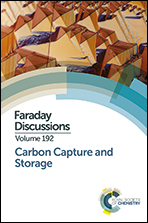A novel methodology for assessing the environmental sustainability of ionic liquids used for CO2 capture†
Abstract
Ionic liquids (ILs) have been proposed as suitable sorbents for CO2 capture because of their high CO2 absorption capacity, thermal stability, negligible vapour pressure and physico-chemical tunability. However, the environmental implications of ILs are currently largely unknown because of a lack of data. The issue is further complicated by their complex chemical structures and numerous precursors for which environmental data are scarce or non-existent. In an attempt to address this issue, this paper presents a new methodology for estimating life cycle environmental impacts of novel ILs, with the aim of aiding synthesis and selection of more sustainable CO2 sorbents. The methodology consists of four main steps: (1) selection of an appropriate IL and synthesis route; (2) construction of a life cycle tree; (3) life cycle assessment; and (4) recommendations for improvements. The application of the methodology is illustrated using trihexyltetradecylphosphonium 1,2,4-triazolide ([P66614][124Triz]), a promising IL for CO2 capture currently under development. Following the above steps, the paper demonstrates how the data obtained from laboratory synthesis of the IL can be scaled up to industrial production to estimate life cycle impacts and identify environmental hotspots. In this particular case, the main hotspots are the precursors used in the synthesis of the IL. Comparison of impacts with monoethanolamine (MEA), currently the most widely-used CO2 sorbent, suggests that [P66614][124Triz] has much higher impacts than MEA, including global warming potential. However, human toxicity potential is significantly higher for MEA. Therefore, the proposed methodology can be used to optimise the design of ILs and to guide selection of more sustainable CO2 sorbents. Although the focus is on ILs, the methodology is generic and can be applied to other chemicals under development.
- This article is part of the themed collection: Carbon Capture and Storage

 Please wait while we load your content...
Please wait while we load your content...